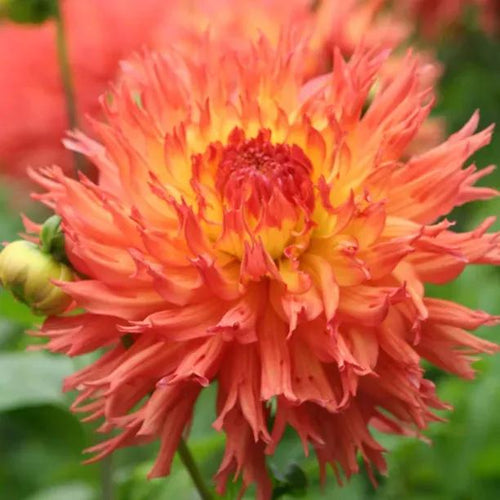Pinelands Pam Dahlia Tubers
Pinelands Pam is an eye-catching yellow and red dahlia that's great for late-season colour a sunny spot. The tactile powderpuff flowers are rich yellow, tipped with red and split at the ends, like a firework caught mid-explosion, and up to 25cm across. With regular deadheading this dahlia will flower from mid summer to the end of autumn, bringing long-lasting drama and colour to borders and pots. The flowers are great for cutting and bringing indoors, where they last well in a vase. Browse our Dahlias here.
Features
- Colour: yellow with red/pink tips
- Flower size: 20-25cm
- Type: fimbriated decorative dahlia
- Cutting: yes, long-lasting in a vase
- Height/spread: 1.2m x 50cm
- Flowering: July to October
- Planting months: end Feb to July
Growing Pinelands Pam Dahlias
She can reach more than 1m in height, so best planted at the centre or towards the back of a sheltered bed or border. The flowers are big and fairly weighty, so you'll need to support the stems with brushwood, canes and string, or special metal plant rings, putting them in when the plants are still small, in late spring, to make life easier. When planting, remember this and be sure to put them somewhere where access isn't too tricky. This will also help when it comes to deadheading (do this and you'll have flowers until the first frosts) and cutting stems to bring indoors. If you're growing dahlias in pots, you'll need something big to do them justice. In borders or pots, they'll need good well-drained, moist soil, so dig in some garden compost or leaf mould to borders.
For failsafe flowers the following year, cut down your plants in early winter, then dig up the tubers. Brush off any soil, then store upside down on trays in a cool shed until spring.
Garden Design Ideas
Try planting with other dahlias in similar bright colours to create a sizzling hot border. Flame-red varieties would look great, or bring out its sunshine colours by threading through a neat yellow pompom dahlia. Towards the front of the border, ornamental grasses such as soft, wafty pennisetums complement dahlias beautifully. Or combine with other late-summer stars in warm colours, such as tagetes, crocosmias, heleniums and rudbeckias.
Combine with fluffy pennisetums in roomy pot on a sunny patio or flanking the front door for a partnership that will just keep on giving.








 Secure, One-Tap Checkout
Secure, One-Tap Checkout
 Hand Picked, Delivered to Your Door!
Hand Picked, Delivered to Your Door! 1 Year Bareroot Guarantee
1 Year Bareroot Guarantee